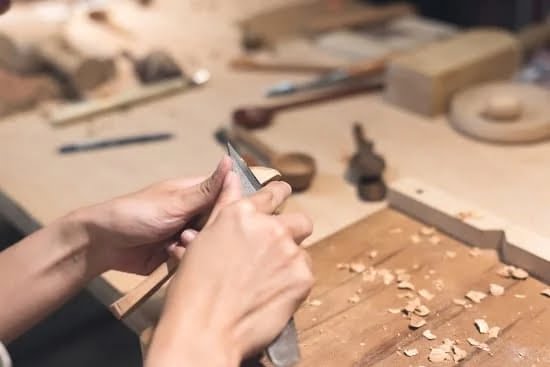Introduction
Specialty woodworking hand tools are specialized tools used for specific tasks in woodworking. These tools allow for precision and accuracy when crafting and developing wood items. Examples of specialty woodworking hand tools include chisels, block planes, coping saws, draw knives and spokeshaves.
These tools have been regularly used for centuries to craft intricate pieces of furniture, sculptures and finishing touches on the surface of wood products. Specialty woodworking hand tools provide a variety of advantages over traditional power equipment such as flexibility, greater control, portability, easier operation, cost savings and safety.
Flexibility is beneficial because it allows you to move the tool around to reach tight spots or ensure accuracy against curves or angles. Greater control is also a benefit because it allows you to precisely execute even minor adjustments with little effort. Additionally, specialty woodworking hand tools are portable which makes them great for outdoor work while being highly accessible in any worksite or home shop when needed.
Ease of operation is another advantage provided by hand tools as they cannot generally get clogged with dust particles like power equipment can during use due to their small scale construction. On top of that, they require little energy expenditure which means they are much cheaper options than expensive machines like jigsaws and routers from a monetary standpoint as well as from an environmental one since there is not motorized engine emitting our carbon emissions during any production use. Finally, these smaller size tools greatly reduce the potential risk of hazard associated with using power equipment under certain conditions making them all-around safer options for users regardless of experience level in the industry.
Necessary Skills
Working with specialty woodworking hand tools requires a certain set of skills. These skills include the ability to assess the grain direction and the knots of various woods, mastering the range of specialty tools available including planes, chisels, saws, gouges and much more. Additionally, you should have knowledge about joinery techniques and be familiar with different cutting techniques such as rip cuts, cross cuts and miters. A strong understanding of shop safety is also necessary so that you can use these tools safely. It’s important to take sharpening your tools seriously; this is an art form that comes with practice and patience. Above all, you should have a good eye for detail =and an appreciation for quality workmanship. These are essential qualities for anyone looking to work with wood in a professional manner.
Different Types
Specialty woodworking hand tools allow skilled woodworkers to create intricate and precise designs. There is a wide variety of specialty hand tools available that serve different purposes. These include planes, chisels, saws, screwdrivers and router bits.
Planes are used to create flat and smooth surfaces on a piece of wood. The blade is used to manually shave off thin layers until the desired level is achieved. The plane can be adjusted or fitted with different blades depending on the job at hand.
Chisels are also essential tools for any woodworker. They are specifically designed for carving into hard woods and removing small amounts of material from larger pieces in order to create recesses or joinery details. Chisels come in many different sizes so the user can choose one that fits the job perfectly.
Saws are used to precisely shape a piece of wood into various shapes when straight lines are needed such as cutting angles or curves into wood. There are several types of saws available, from coping saws to jigsaws depending on what is required for any particular project.
Screwdrivers are essential for assembling furniture pieces together with screws, as well as separating wooden components without damaging either item. Additionally, screwdrivers can be used for specially designed screws that have unique head shapes which regular screws cannot accommodate (for example drywall screws).
Router bits are specialized tools used both manually and in machines such as routers or saws to cut profiles into woods or metal surfaces in order to create precisely shaped decorative edges along a piece of material or make cuts with curved lines like those found on dovetails and finger joints.
Care and Maintenance
Specialty woodworking hand tools should always be properly cared for and maintained in order to protect the user and extend the lifespan of the tools. To properly care for and maintain specialty woodworking hand tools, there are a few steps that can be taken.
First, users should always make sure to keep tools clean and free from dirt, dust, moisture, and other debris. This can be done by using a damp cloth or soft brush to gently brush away any buildup on the tool’s surface. It is important not to use any abrasive cleaning materials or substances as these may scratch or damage the tooling.
In addition to keeping surfaces clean, all blades should be regularly honed using an appropriate sharpening stone or file. If working with more delicate tools such as chisels or carving knives, more careful attention should be given when sharpening in order to get the right angle and keep edges precise.
Finally, it is wise to periodically inspect hand tools for signs of damage and wear. If any issues are noticed such as bent handles, cracked wooden parts, or cracked plastic parts then necessary repairs should be made before further usage of the tool can occur. This will help ensure that skills are used safely and that tools remain in optimal condition for long-term use.
Safety
Working with specialty woodworking hand tools is an effective way to bring your projects to life, but it does come with some risks. To remain safe and keep your work environment hazard-free, there are several safety considerations to keep in mind.
First and foremost, wear appropriate gear when you’re working. Consider protective eyewear to minimize exposure to flying objects from sawing or hammering; ear protection if working with loud machines; gloves and arm guards for physical protection when using sharp tools; and a dust mask if using power sanders. Also make sure that you’re wearing shoes or boots that will help you maintain optimal footing when moving around the job site.
In addition, inspect all your tools before use. Clean any debris off cutting edges and sharpen dull blades as needed. Check clamps for any damage or broken pieces that may need replacement and replace worn out drill bits or saw blades accordingly. Lastly, make sure all cords are properly connected to the right power source and double check the voltage setting on saws, routers, planers and other tools you’re using.
By following these precautions and making safety a priority in your woodworking shop, you can get the most out of your specialty hand tools without compromising your wellbeing.
Selection
When choosing a specialty woodworking hand tool, one should consider the type of job it will be used for. Depending on the project, different types of tools may be best suited. If the job requires intricate detail work, then a chisel set designed for fine carpentry will likely be the appropriate choice. Conversely, if a large-scale project is underway, then heavier duty saws and hammers may be necessary.
It’s also important to assess the quality of the tool in question. Specialty woodworking hand tools are often expensive so seeking out ones that have been made with superior craftsmanship is key. Other considerations include the weight and size of the tool as well as its ease of use”some may require more strength than others to operate accurately. Additionally, ensuring all pieces of a set (if applicable) support each other’s purpose and provide versatility when working on projects is important. Users should also determine if any additional features such as a dust guard or additional safety functions are applicable for their needs. Doing so can provide further protection for both users and their work pieces.
Troubleshooting
When working with specialty woodworking hand tools, woodworkers may face a variety of issues. Most common issues include:
• Dull blades – If a blade is dull, it will not cut correctly and can easily cause an inaccurate result. To troubleshoot, make sure the blade is properly sharpened with a quality file or sharpening stone. Be careful not to over sharpen as this could cause the edge of the blade to chip or end up too thin for successful use.
• Poor blade alignment – If the tip or shoulder of a tool is incorrectly placed or off-center, this will undoubtedly lead to some cutting issues such as splintering, burning or chipping. Troubleshooting involves making sure that blades are properly centered and have the correct angle matching the curved surface being cut. Use a cylinder gauge micrometer and tech pencils to help adjust and set the proper angles while ensuring that blades are exactly at 90° angle.
• Clogged chisels – Chisels can quickly become clogged if not used properly. Before starting work, always clean out old chips from tool’s throat so they don’t jam the shape or size of cutting edges during operation; also ensure your bench vise isn’t holding chisel in incorrect position when working on tight areas. Troubleshooting involves gently hammering out any stuck parts free from blockage with a soft-faced mallet and replacing worn out parts before attempting further cuts.
• Bent carving tools – The most common issue with bent carving tools is poor design. Make sure that you are using quality-made tools as they are better balanced than cheaper alternatives and can handle more stress without bending or becoming damaged in any way. It’s easiest to troubleshoot this issue by visually inspecting each tool for signs of wear & tear before beginning work; replace those which appear worn down to maintain quality performance level in all operations.
Tips & Tricks
When using specialty woodworking hand tools, it is important to be aware of their specialized uses and limitations. For example, a chisel should only be used on soft wood as it could break when subjected to harder surfaces. When using a saw, ensure that the teeth are facing the right direction when cutting in order to avoid the material being pushed or wedged instead of sliced through. An awl can be useful for marking or piercing holes in tight spots, while a gouge can be helpful for hollowing out curved surfaces or scooping out corners.
Another tip is to angle the blade of your tool at exactly 90 degrees when you make a cut in order to achieve an even finish. When drilling into wood with a drill bit, remember to slowly increase its depth in order to prevent any shattering or splintering of the material. You should also keep sharpening stones handy if you want best results from your specialty tools since they will become dull much more quickly than regular tools due to their more specialized usages. Finally, never force any tool past its limits as this can result in blemishing the wood’s surface or impairing its quality.
Conclusion
Specialty woodworking hand tools provide an effective way to work with wood. They allow for precise and intricate cuts, as well as more rugged shapes. These tools also help to create attractive designs that stand out from amateur items, giving the maker a unique result. Additionally, when used correctly they can create pieces that require little or no additional sanding or finishing. As such, specialty woodworking hand tools are an invaluable asset in any woodworker’s toolbox.
For those wishing to explore more deeply the benefits of specialty woodworking hand tools, there are many directions available. Reading books by experts on the use of these tools is one option for further exploration, as is joining membership forums for people who specialize in using them. Taking classes at a local maker space or trade school is another beneficial recommendation because some hands-on experience is invaluable in mastering the use of speciality tools. With dedication and practice, every enthusiast can soon unlock all of the potential these remarkable tools have to offer.

Hi everyone! I’m a woodworker and blogger, and this is my woodworking blog. In my blog, I share tips and tricks for woodworkers of all skill levels, as well as project ideas that you can try yourself.





